Mr Faizan Ali is currently studying strategic and defence studies.
Introduction
The Middle Eastern region is described as a region of crises, chaos, rivalries, civil wars, proxies, and conflicts as its frontlines. Both the Islamic Republic of Iran and the Kingdom of Saudi Arabia are two Islamic majority states in the Middle East that are geographically separated by the Persian Gulf. The Saudi-Iranian relations are strained and characterized by bitterness, enmity, and rivalry.
Both countries are in a continuous struggle for regional dominance because of their variances in religious, ideological, geopolitical, and economic interests.1 The two states are engaged in indirect confrontations, using indirect strategies of proxy wars and insurgencies against each other as opportunities to maximize their interests. The Saudi-Iranian rivalry is also known as the Middle East’s “Cold War”, where the whole region is the battlefield.
Moreover, the differences between the two states intensified the complexity of the conflict between the rivals due to the presence of militant groups, non-state actors, and proxies in the region. This power struggle and the rivalry among the two Middle Eastern powers have roots deep into history; the animosity having evolved from the time of the Iranian Revolution of 1979, the demise of Saddam Hussein, the Arab uprisings, and several others.
The external powers such as the United States of America and that of Russia also hold significance in shaping the rivalry which has been there for decades.2 This strained and growing rivalry can bring the dark clouds of inadvertent war with consequences in the region and also far beyond the region.
The Iranian Revolution
The Iranian Revolution of 1979 was a triggering point of sparking the rivalry between the two countries of the Middle East. The monarchial regime under the Pahlavi dynasty of Mohammad Raza Shah Pahlavi was overthrown as a result of the 1979 revolution and Iran was replaced with the Islamic republic — a theocratic regime under Ayatollah Khomeini.
The Islamic republic held anti-western, anti-colonist, anti-imperialist values and sentiments at its core. It also had a goal of exporting the revolution within Iran and beyond its border and hence the Iranian revolution terrified the Saudi government as they feared that it might also lead to the toppling of the Saudi monarchy.
Both Iran and Saudi Arabia view themselves as the representatives of the Islamic world as they have the majority followers of two main Islamic sects: Shia and Sunni. Ayatollah Khomeini criticized the Saudi interpretation of Islam and its hold over the holy places of Mecca and Medina and claimed the Iranian version as legitimate, while the Saudi monarchy claimed their version as religiously legitimate.
The attempts to undermine each other’s legitimacy enabled the sectarian or religious divide and this, in return, created the foreign policy priorities of Iran and Saudi Arabia. Both countries have formed alliances with countries that share their version of Islam, deepening the tensions between the two states as Iran considered itself as an autonomous country, whereas the Saudi government considered defending its monarchial rule aligned with foreign powers.3
The Demise of Saddam Hussein
The eight-year-long Iran-Iraq war (1980-1988) is also seen to be a catalyst in the rivalry between Iran and Saudi Arabia as the Saudi government provided the logistics, support, and money to the Sunni-led Iraqi government under Saddam Hussein. In the year 2003, the United States’ invasion of Iraq and toppling down of the dictator Saddam Hussein intensified the enmity between Iran and Saudi Arabia as the U.S.’s invasion made Iraq a failing state and created a power vacuum ending Iraq into bloody civil war.
This provided an opportunity for Iran and Saudi Arabia to expand their influence and power to bring their friendly governments with the help of proxy wars. In the quest for regional dominance, Iran sponsored and financed support to several Shia militia groups, while Saudi provided support to several Sunni militia groups in the country.4
The Arab Spring
The differences between Saudi Arabia and Iran sharpened as the trend of supporting the opposing groups according to their interests was followed in 2011 in the wave of popular uprisings demanding regime change and social or civil rights in various states of the region. The Saudi government tried to defend the monarchial rule and the tensions rose as Iran supported Shia militia groups and Shia governments while Saudi Arabia supported Sunni groups and governments.
For instance, in Tunisia, the Saudi regime helped the Zayn al-Abidin, while Iran stood against them. Similarly, in Bahrain, Iran assisted the Shia leaders, but Saudi Arabia sent troops to suppress the anti-government revolt. In Lebanon, the Saudi government supported Prime Minister Saad Hariri while Iran backed Hezbollah, the anti-government Shia party; similarly, in Libya and Morocco, both states backed opposing groups.
This has led the state structures of these states to weaken or collapse. In Syria, Iran has been backing President Bashar al-Assad’s regime and other groups supporting Assad’s regime such as Hezbollah, while Saudi Arabia is financially supporting rebel groups. In Yemen, Saudi Arabia, under Mohammad Bin Salman, has been carrying out military campaigns against the Houthi rebels which are Iranian-backed militias or proxy groups, and supporting Yemeni President Abd-Rabba Mansur and his government.5
Nimr Al-Nimr Execution
In 2016, Saudi-Arabia and Iran’s relations intensified when Saudi Arabia executed Sheikh Nimr-al-Nimr, a prominent Shia cleric, and almost 46 others of which most were supporters of the Shia community. Al-Nimr supported mass anti-monarchy protests openly and was famous for criticism of the ruling regime of the Al-Saud family. In response to the execution of al-Nimr, which the Saudi government accused him of terrorism charges, protests in Shia-dominated states were organized with varying degrees of rage.
In Tehran, the Saudi embassy was set ablaze and the offices were ransacked.6 “God’s hand of retaliation will grip the neck of Saudi politicians,” said Ayatollah Ali Khamenei, Iran’s supreme leader. The action-reaction of the two states marked a swift escalation of the old struggle of power and the deepened sectarian rivalry between the two.
Adel al-Jubeir, the Saudi foreign minister, in response to Iran’s condemnation accused it of “blind sectarianism” and of spreading terrorism and announced the cutting off of diplomatic ties at a news conference in Riyadh, saying “The Kingdom would not allow Iran to undermine its security. The history of Iran is full of negative and hostile interference in Arab countries, always accompanied by ruin, destruction and the killing of innocent souls,”.7
Analysis
Saudi Arabia and Iran are using indirect strategies of proxy wars and insurgencies against each other. Every other means they found to benefit them they use it as potential opportunities to maximize their interests and strengthen their positions considering the relative gains of their states.8 Through the lens of Realism, states use power for serving their respective national interests in International relations.
Hans J. Morgenthau stated that “international politics, like all politics, is a struggle for power. Whatever the ultimate aims of international politics, power is always the immediate aim or means to an end”.9 The decades-long and growing rivalry of the two states is a religious, political, ideological struggle based on the interests of the states to hold control over the resources and hold dominance, influence, and power in the region along religious and political lines.
The hegemonic desires not only endanger peace and prosperity but also worsen the circumstances. The decades’ rivalry has created insecurity in the region by destabilization of the region already in disarray and chaos. The fear and suspicions generated in the hearts and minds of the two states have with the passage of time caused the uncertainty of the actions or intentions between the two rival countries.
The growing uncertainty has led to the creation of a security dilemma among the rival states which, in turn, has prompted the two states to go into series of actions and reactions to counterbalance each other’s power and influence, and to reinforce their relative dominance in the region.
The acrimony, coupled with the Shia-Sunni divide and other inspirations, has changed the security of the region as conflicting in nature. The security complex of the Middle Eastern region is prevailed by the pattern of enmity and hostility rather than the pattern of amity and peace. This pattern has indulged the two rivals into incitement of proxy wars, efforts to fill the power vacuum, indirect conflicts, insurgencies, and the support of varying groups or militias.10
This security complex based on the relationship of enmity, feud, bitterness, and aggressiveness can lead to further destabilization of the region. The strained and growing rivalry can bring the dark clouds of inadvertent war in the region and also far beyond the region, with consequences such as destruction, famine, and unwanted death of millions.
Conclusion
The Saudi-Iranian rivalry is a continuous struggle for regional dominance and power maximization. The two states, the Islamic Republic of Iran and the Kingdom of Saudi Arabia, are struggling to gain their interests and to enhance the sphere of influence through different means. The pattern of relationship of enmity and bitterness between Iran and Saudi Arabia has only produced undesirable gains so far.
It would be better for the two states to engage in bilateral talks seeking cooperation, reconsidering their desires, and reconstructing their perceptions about each other. It is required that the leaderships of both states understand the need for changing their behaviors and attitudes towards each other. It would help reduce the uncertainty to at least some level, prevent the region from further instability, and enmity between the two can be replaced with peace and friendship.
Endnotes
[1] Now This World, “Why Do Saudi Arabia And Iran Hate Each Other?” YouTube, April 5, 2015, Accessed January 22, 2021, https://www.youtube.com/watch?v=G-dMM3HRnhY.
[2] Vox, “The Middle East’s cold war, explained.” YouTube, July 17, 2017, Accessed January 22, 2021. https://www.youtube.com/watch?v=veMFCFyOwFI.
[3] TRT World, “Why are Iran and Saudi Arabia enemies?” YouTube, November 30, 2018, Accessed January 22, 2021. https://www.youtube.com/watch?v=IcElYG1Tdr0.
[4] Marcus, Jonathan, “Why Saudi Arabia and Iran Are Bitter Rivals.” BBC News, Last modified September 16, 2019, https://www.bbc.com/news/world-middle-east-42008809.
[5] Amanda Erickson, “What’s behind the feud between Saudi Arabia and Iran? Power.” The Washington Post, Last modified December 20, 2017. https://www.washingtonpost.com/news/worldviews/wp/2017/12/20/whats-behind-the-feud-between-saudi-arabia-and-iran-power/.
[6] Binoy Kampmark, “Out in the Open: Saudi Arabia, Iran and the Execution of Sheik Nimr Al-Nimr.” E-International Relations, Last modified January 27, 2016.
[7]Ben Hubbard, “Saudi Arabia Cuts Ties With Iran Amid Fallout From Cleric’s Execution (Published 2016).” The New York Times – Breaking News, US News, World News and Videos, Last modified January 13, 2016, https://www.nytimes.com/2016/01/04/world/middleeast/iran-saudi-arabia-execution-sheikh-nimr.html.
[8] Beauchamp, Zack, “Iran and Saudi Arabia’s Cold War is Making the Middle East Even More Dangerous.” Vox, Last modified March 30, 2015. https://www.vox.com/2015/3/30/8314513/saudi-arabia-iran.
[9] Paul R.Viotti and Mark V. Kauppi, International Relations Theory, (New York: Pearson Education, 2012), 39-42.
[10] Michaela Cruden, “Regional Security Complex Theory: Southeast Asia and the South Pacific – CORE Reader.” CORE – Aggregating the World’s Open Access Research Papers, Last modified November 17, 2011. https://core.ac.uk/reader/29199640.
Bibliography
- Amanda Erickson. “What’s behind the feud between Saudi Arabia and Iran? Power.” The Washington Post, Last modified December 20, 2017. https://www.washingtonpost.com/news/worldviews/wp/2017/12/20/whats-behind-the-feud-between-saudi-arabia-and-iran-power/.
- Beauchamp, Zack. “Iran and Saudi Arabia’s Cold War is making the Middle East Even More Dangerous.” Vox, Last modified March 30, 2015. https://www.vox.com/2015/3/30/8314513/saudi-arabia-iran.
- Ben Hubbard. “Saudi Arabia Cuts Ties with Iran amid Fallout from Cleric’s Execution (Published 2016).” The New York Times – Breaking News, US News, World News and Videos, Last modified January 13, 2016. https://www.nytimes.com/2016/01/04/world/middleeast/iran-saudi-arabia-execution-sheikh-nimr.html
- Binoy Kampmark, “Out in the Open: Saudi Arabia, Iran and the Execution of Sheik Nimr Al-Nimr.” E-International Relations, Last modified January 27, 2016. https://www.e-ir.info/2016/01/25/out-in-the-open-saudi-arabia-iran-and-the-execution-of-sheik-nimr-al-nimr/.
- Marcus, Jonathan. “Why Saudi Arabia and Iran Are Bitter Rivals.” BBC News, Last modified September 16, 2019. https://www.bbc.com/news/world-middle-east-42008809.
- Michaela Cruden. “Regional Security Complex Theory: Southeast Asia and the South Pacific – CORE Reader.” CORE – Aggregating the World’s Open Access Research Papers, Last modified November 17, 2011. https://core.ac.uk/reader/29199640.
- Now This World, “Why Do Saudi Arabia And Iran Hate Each Other?” YouTube, April 5, 2015, Accessed January 22, 2021. https://www.youtube.com/watch?v=G-dMM3HRnhY.
- TRT World, “Why are Iran and Saudi Arabia enemies?” YouTube, November 30, 2018, Accessed January 22, 2021. https://www.youtube.com/watch?v=IcElYG1Tdr0.
- Vox, “The Middle East’s cold war, explained.” YouTube, July 17, 2017, Accessed January 22, 2021. https://www.youtube.com/watch?v=veMFCFyOwFI.
If you want to submit your articles and/or research papers, please check the Submissions page.
The views and opinions expressed in this article/paper are the author’s own and do not necessarily reflect the editorial position of Paradigm Shift.


















